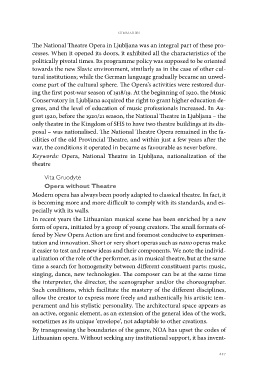Page 439 - Weiss, Jernej, ur. 2019. Vloga nacionalnih opernih gledališč v 20. in 21. stoletju - The Role of National Opera Houses in the 20th and 21st Centuries. Koper/Ljubljana: Založba Univerze na Primorskem in Festival Ljubljana. Studia musicologica Labacensia, 3
P. 439
summaries
The National Theatre Opera in Ljubljana was an integral part of these pro-
cesses. When it opened its doors, it exhibited all the characteristics of the
politically pivotal times. Its programme policy was supposed to be oriented
towards the new Slavic environment, similarly as in the case of other cul-
tural institutions; while the German language gradually became an unwel-
come part of the cultural sphere. The Opera’s activities were restored dur-
ing the first post-war season of 1918/19. At the beginning of 1920, the Music
Conservatory in Ljubljana acquired the right to grant higher education de-
grees, and the level of education of music professionals increased. In Au-
gust 1920, before the 1920/21 season, the National Theatre in Ljubljana – the
only theatre in the Kingdom of SHS to have two theatre buildings at its dis-
posal – was nationalised. The National Theatre Opera remained in the fa-
cilities of the old Provincial Theatre, and within just a few years after the
war, the conditions it operated in became as favourable as never before.
Keywords: Opera, National Theatre in Ljubljana, nationalization of the
theatre
Vita Gruodytė
Opera without Theatre
Modern opera has always been poorly adapted to classical theatre. In fact, it
is becoming more and more difficult to comply with its standards, and es-
pecially with its walls.
In recent years the Lithuanian musical scene has been enriched by a new
form of opera, initiated by a group of young creators. The small formats of-
fered by New Opera Action are first and foremost conducive to experimen-
tation and innovation. Short or very short operas such as nano operas make
it easier to test and renew ideas and their components. We note the individ-
ualization of the role of the performer, as in musical theatre, but at the same
time a search for homogeneity between different constituent parts: music,
singing, dance, new technologies. The composer can be at the same time
the interpreter, the director, the scenographer and/or the choreographer.
Such conditions, which facilitate the mastery of the different disciplines,
allow the creator to express more freely and authentically his artistic tem-
perament and his stylistic personality. The architectural space appears as
an active, organic element, as an extension of the general idea of the work,
sometimes as its unique ‘envelope’, not adaptable to other creations.
By transgressing the boundaries of the genre, NOA has upset the codes of
Lithuanian opera. Without seeking any institutional support, it has invent-
437
The National Theatre Opera in Ljubljana was an integral part of these pro-
cesses. When it opened its doors, it exhibited all the characteristics of the
politically pivotal times. Its programme policy was supposed to be oriented
towards the new Slavic environment, similarly as in the case of other cul-
tural institutions; while the German language gradually became an unwel-
come part of the cultural sphere. The Opera’s activities were restored dur-
ing the first post-war season of 1918/19. At the beginning of 1920, the Music
Conservatory in Ljubljana acquired the right to grant higher education de-
grees, and the level of education of music professionals increased. In Au-
gust 1920, before the 1920/21 season, the National Theatre in Ljubljana – the
only theatre in the Kingdom of SHS to have two theatre buildings at its dis-
posal – was nationalised. The National Theatre Opera remained in the fa-
cilities of the old Provincial Theatre, and within just a few years after the
war, the conditions it operated in became as favourable as never before.
Keywords: Opera, National Theatre in Ljubljana, nationalization of the
theatre
Vita Gruodytė
Opera without Theatre
Modern opera has always been poorly adapted to classical theatre. In fact, it
is becoming more and more difficult to comply with its standards, and es-
pecially with its walls.
In recent years the Lithuanian musical scene has been enriched by a new
form of opera, initiated by a group of young creators. The small formats of-
fered by New Opera Action are first and foremost conducive to experimen-
tation and innovation. Short or very short operas such as nano operas make
it easier to test and renew ideas and their components. We note the individ-
ualization of the role of the performer, as in musical theatre, but at the same
time a search for homogeneity between different constituent parts: music,
singing, dance, new technologies. The composer can be at the same time
the interpreter, the director, the scenographer and/or the choreographer.
Such conditions, which facilitate the mastery of the different disciplines,
allow the creator to express more freely and authentically his artistic tem-
perament and his stylistic personality. The architectural space appears as
an active, organic element, as an extension of the general idea of the work,
sometimes as its unique ‘envelope’, not adaptable to other creations.
By transgressing the boundaries of the genre, NOA has upset the codes of
Lithuanian opera. Without seeking any institutional support, it has invent-
437


